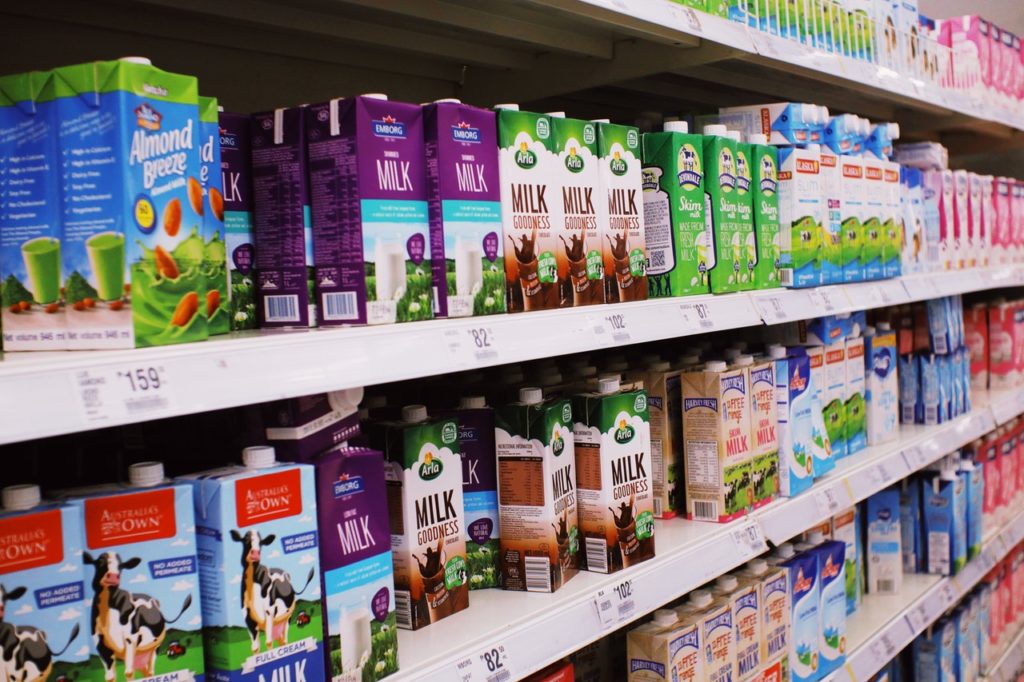
Why does UHT milk last so long? UHT stands for Ultra High Treatment and it is heated at 138℃ for 2 seconds to kill all the bacteria.
All milk you buy in the shop has been pasteurized. In most countries it is illegal to sell unpasteurized milk because of the dangers. Unpasteurized milk can contain bacteria such as salmonella, E. coli, Listeria, Campylobacter, and others. These bacteria can all cause different illnesses and many are fatal. Milk doesn’t definitely have these bacteria, but it is more likely to have them than any other food. Bacteria grow exceedingly well in milk and raw milk is responsible for three times more hospitalizations than other foods. It is also possible to catch tuberculosis from milk and that killed 65,000 people in England between 1912 and 1937. Most governments have come to the realization that it is better to insist on pasteurizing milk than it is to risk the diseases and deaths. It has been mandatory in most American states since 1947 and all of them since 1973.
Pasteurization was discovered long before Louis Pasteur gave his name to it. It has been practiced in China for over a thousand years. However, people probably didn’t know why heating kept things from going bad. The power of disinfection was discovered by Ignaz Semmelweis in 1848 and Robert Koch discovered the tuberculosis pathogen in 1882. Louis Pasteur worked out that chemical reactions caused by micro-organisms were responsible for spoiling beer, and wine. He discovered that heating the liquid to between 60 and 100 degrees killed most of the bacteria in it and stopped the chemical reactions. This led him to raise the idea that micro-organisms entered the human body, leading to advances in antiseptics and later on vaccines.
Louis Pasteur wasn’t the first person to suggest pasteurizing milk. That was Frans von Soxhlet, a German agricultural chemist. He knew that raw milk could carry typhoid, scarlet fever, diphtheria, tuberculosis, and other diseases. He suggested that milk was pasteurized before sale to the public. In 1891, one in every four infants in New York City died from drinking tainted milk. This fell to one in fourteen after pasteurization was introduced.
So, why does UHT milk last so long? There are two ways of pasteurizing milk. It can be heated to 72℃ for 15 seconds or 138℃ for 2 seconds. Most milk we buy in the shop is the former. The milk producer has to ensure that all of the particles of milk are heated to 72℃ for 15 seconds, which means the milk flow has to be adjusted so all parts of the milk are heated for long enough. 72℃ is theoretically hot enough to kill almost all bacteria, but recently some countries have decided to raise the heat requirement to ensure that even more bacteria are killed.
Regular milk has a shelf life of up to 21 days if properly refrigerated. The colder it is kept, the longer it will last before going bad because bacteria reproduce more slowly in the cold. Where do the bacteria come from? Pasteurizing doesn’t kill all of the bacteria and the ones that are left reproduce. Either that, or they enter during the bottling process.
UHT milk is heated to 138℃ for 2 seconds. This heat is high enough to kill pretty much all of the bacteria present in the milk. The milk is considered to be sterile. It is bottled in a sterile environment as well. If left unopened, it can have a shelf life of up to 180 days. Once opened it has to be refrigerated in the same way as regular milk because bacteria get inside. It won’t last forever because most of the bottles or cartons are not hermetically sealed and bacteria can always wiggle their way into the container. UHT milk tastes slightly different to regular pasteurized milk, but it is safer and lasts longer. The heating process causes the Maillard browning effect, which is what makes toast brown, and changes the milk’s taste a little.
The UHT process was invented in 1893, but direct heat was applied, and it didn’t heat all of the milk equally. In 1912, a method was invented where the milk was heated using steam. The steam was mixed with the milk and brought all of the milk to the desired temperature. This worked, but the packaging system wasn’t sterile enough and bacteria still managed to get into the milk. In 1953, a way of injecting steam was invented that raised the temperature of the milk instantly and the milk was packaged in sterile cans. In the 1960s, it became possible to sterilize cartons, heat the milk, and pack everything in a completely sterile environment, solving all of the problems.
UHT milk doesn’t need to be refrigerated, so it is much cheaper to transport than regular milk. It was introduced into America in 1993, but many people won’t drink it because they don’t trust milk that isn’t refrigerated, despite it being safer. To get around this, the UHT milk is actually sold from the refrigerator, which is unnecessary and a waste of electricity. UHT milk is popular across Europe, especially in hot countries. The milk served in single serve milk pots in places like airplanes is UHT milk.
So, why does UHT milk last so long? It has been heated high enough that all of the bacteria have been killed and it is hermetically sealed in a sterile environment. And this is what I learned today.
Sources
https://en.wikipedia.org/wiki/Louis_Pasteur
https://en.wikipedia.org/wiki/Pasteurization
https://www.dairy.com.au/products/milk/long-life-milk
https://en.wikipedia.org/wiki/Ultra-high-temperature_processing
https://www.usdairy.com/news-articles/uht-milk-what-is-ultra-high-temperature-milk
https://en.wikipedia.org/wiki/Milk#UHT
https://www.pritchitts.com/products/milk-portions
https://corporate.evonik.com/en/the-discovery-of-bacteria-138063.html
https://www.dairyscience.info/index.php/food-model/277-htst-pasteurization.html

